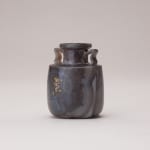Roman Banded Agate Amphoriskos, 100 BCE - 100 CE
Agate
2.375
DC.146
For all of the beautiful works of bronze and glass that decorated the Roman house-hold, nothing was quite the symbol of opulence, of grandeur, and of sophistication, like the possession...
For all of the beautiful works of bronze and glass that decorated the Roman house-hold, nothing was quite the symbol of opulence, of grandeur, and of sophistication, like the possession of a vessel made of agate, or another semi-precious stone. There can be no more than a half-dozen pieces of this nature surviving from Antiquity, and the carving process for these stones was so laborious and challenging, that most artists could produce no more than crude hollows in which perfumes or spices could be placed.
The tapered spout and magnificently delicate handles demonstrates a degree of meticulous toil that is on par with some of the most masterful artisanship in history.
This amphoriskos consists of thick walls, a deeply hollowed interior, a cylindrical body with a flat base and sharply-carinated shoulders, a short cylindrical neck and overhanging disk rim, tapering slightly inward on its upper surface, the two angled handles with concave sides, merging at the shoulders and below the rim.
For a very close example likely from the same workshop, see no.393 in Picon, et al., Art of the Classical World in the Metropolitan Museum of Art. The authors note that, "vessels made in semiprecious stone were much sought after as a symbol of wealth and sophistication."
The tapered spout and magnificently delicate handles demonstrates a degree of meticulous toil that is on par with some of the most masterful artisanship in history.
This amphoriskos consists of thick walls, a deeply hollowed interior, a cylindrical body with a flat base and sharply-carinated shoulders, a short cylindrical neck and overhanging disk rim, tapering slightly inward on its upper surface, the two angled handles with concave sides, merging at the shoulders and below the rim.
For a very close example likely from the same workshop, see no.393 in Picon, et al., Art of the Classical World in the Metropolitan Museum of Art. The authors note that, "vessels made in semiprecious stone were much sought after as a symbol of wealth and sophistication."



